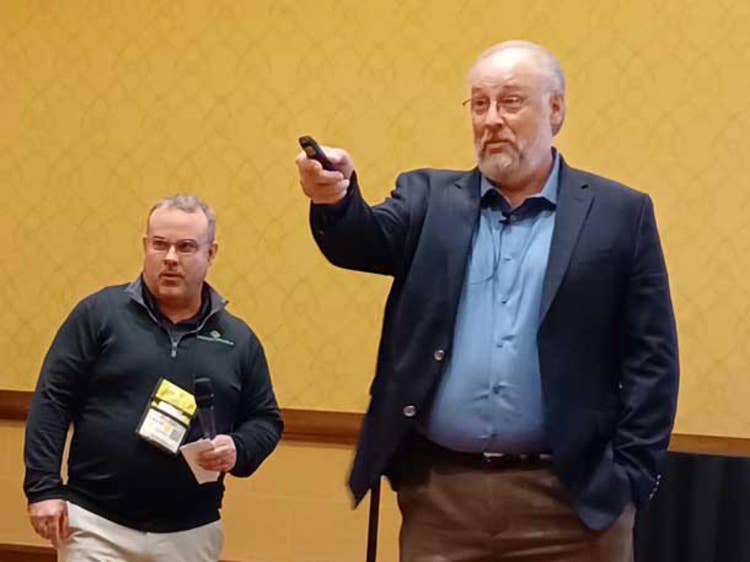7 Ways To Build A ‘Sticky’ Managed Services Practice
‘Sooner or later, [a customer is] going to replace a switch. They’re going to upgrade a firewall. They’re going to have 30 users go home and have to work from home for the next six months, a year, a year and a half. Then they’re going to need help setting that up. So you can jump in there and be their savior,’ says David Cox, director of operations at G6 Communications.

Building “Sticky” Services
MSPs have been told time and time again that “stickiness,” or holding on to their customers throughout the business relationshp, is key to building a successful managed service practice. But doing so can require a combination of effort and patience, according to two MSP executives who have found success and shared some of the methods they used.
Wayne Hunter (photo, right), co-founder and CEO of Allen, Texas-based AvTek Solutions, and David Cox, director of operations at New Haven, Ind.-based G6 Communications, had an open discussion with fellow MSPs at the recent XChange+ 2021 conference and talked about some of the ways they bring traditional IT customers into managed services as well as how they bring managed services customers into higher-margin co-managed services.
Hunter told his peers that his company started as a traditional solution provider with an enterprise focus and eventually moved toward the MSP model, while many MSPs start with smaller customers and try to move up the stack.
“When you get that model, and now you want to move up, now you have to change how you think, how you approach, how you sell, how you communicate,” he said. “Some can do it, some are struggling to try to do it, and others have found a way to be successful.”
Cox said his company started as a true MSP.
“We did everything, and we did nothing,“ he said. ”We walked away from a lot of business where there was no opportunity to go in and take over. We found out about three years ago that that was a huge mistake. We were missing out on some great opportunities.”
Hunter and Cox shared seven tips on shifting a business into managed and co-managed services and how to manage those services to keep customers asking for more.

Focus On High-Margin Business
Tier-one help desk support is a common but low-margin part of an MSP’s business, Hunter said.
“If you take that off, now I’m focusing on things that once I get right is high-margin business,” he said. “I’m monitoring their servers. I’m making sure they‘re patched. I monitor the network and firewalls and making sure they’re patched. We’ll take care of the reactionary work. That’s what we’re trying to do.”
One MSP in the audience asked whether it makes sense to have an in-house team to help customers with their legacy applications.
“Yes, there will be companies that don’t want to take it,” Hunter said. “Do you really want to do the legacy apps?”
When the MSP noted that he was referring to IBM AS/400 mainframe legacy apps, Hunter said the situation there is different in that the profit comes from other areas.
“Usually you can’t touch that,” he said. “But if there’s security monitoring on that, and for most people it’s not, now that’s something you can do.”
However, he said, with the legacy app in this case, there are limits to what an MSP can do.
“Do you want to support that? No,” he said. “So how do we go about saying, ‘We don’t want to support that.’ If I can’t patch it, I don’t want to own it. It’s that simple. One of those navigation things that you have to go out and do is, ‘What can I do for you so I can get an SLA?’ You’re still going to do the same things you’ve done as an MSP, where you don’t normally pitch SLAs. You’re going to do all those types of things, but now your approach is a little bit different.“

Build Higher-Margin Capabilities With Automation
To get it right, your margin has to get higher, Hunter said.
“How much of your engineering time should you do with your tier-two, tier-three, tier-four [support]?” he said. “How much time should you be spending on monitoring services that are patching or doing those things? Not a whole lot. The client comes and tells me if it’s out of patch, the maintenance is automated through RMM, I’m gold right now.“
When you add automation, one of the biggest benefits is less manpower, which really changes the relationship with the MSP, Hunter said.
“When you’re a straight MSP, you’re not dealing with the IT team,” he said. “You’re dealing with a business owner, the CFO, the CTO, whoever it may be that sounds important. And that’s all you’re doing. It’s only one person. All we have to sell is that one person.”
Cox said often the simplest MSP capabilities can open more doors to opportunities within customers.
An MSP may be helping customers keep their patches up to date and give them a nice single pane of glass look at their systems, but it may not be enough, he said.
“All of them have a ticketing system,” he said. “They’re using Teams, they’re using Slack, they’re using stickies, they’re using all kinds of different things to track all their incidents, but it was impossible to figure out what they did six months ago when [a problem] happened again six months later. There was no way to track that down. With our ticketing system, they have access to our full knowledge base.”

Start The Right Conversation
It can be easy to start a conversation with a potential customer that doesn’t want to deal with MSPs but who can be shown it is lacking tools to run its business more easily, Cox said.
“They probably think they’re covered, but we might be able to sell them some tools here and there that are going to make their life easy,” he said. “And every little bit that you can push that door open is another opportunity in six or eight months. Sooner or later, they’re going to replace a switch. They’re going to upgrade a firewall. They’re going to have 30 users go home and have to work from home for the next six months, a year, a year and a half. Then they’re going to need help setting that up. So you can jump in there and be their savior.”
MSPs who can get in the door at bigger companies will be the first call every time something comes up, Cox said.
“Maybe you’re just taking them out to lunch and talking about HIPAA,” he said. “You were talking about SIEM [security information and event management]. And you’re talking about pen [penetration] tests. But when you’re a part of every conversation they have, you really start to build your business.“
Cox gave as an example a prospective customer who had a firewall issue after another local solution provider wasn’t able to resolve it.
“He needed our expertise,” he said. “We went in there and hit it out of the park. Now we charge them about $2,500 a month to monitor their networks, give them all the tools. Zero labor, we just give them the tools. And we just refreshed their data center, which has generated over $100,000 in revenue in two years.”

Reach Higher In The Customer Organization Chart
Hunter said reaching up into the customer’s organization to upper-level executives is a winning strategy.
“Who is it I do not want in there?” he said. “System administrators. The guys, the ladies working for that IT director. You’ve got to convince them that you’re there to make them successful. And that’s the truth. It‘s all about that. [Tell them] ‘I want you to focus on your business being successful and being the heroes for the users that you support. We’ll sit behind the scenes, not seen, and make sure you don’t have to deal with reactionary work with the servers and networks.’”

Engage In Co-Managed Services
Co-managed services is a big way for MSPs to grow their business, Cox said.
“Back when managed services really became big in the channel, ultimately we took what enterprises had in place and we provided it to SMBs,” he said. “And so what we’re ultimately doing with co-managed services is we’re taking what managed services is doing and extending it to clients to give them the best of both worlds.”
The right tools are the key to stickiness in co-managed services, Hunter said.
“When [customers] have a problem, they’re overloaded and throw the problem over the wall to us, we just jump right in a solve it, and say, ‘Here’s the documentation of what we did. So the next time you can fix it yourself,’” he said.
In this situation, customers know the MSP ready to support them, Hunter said.
“They know we’re that blanket over them, that security blanket,” he said. “And that we’re not trying to take their job.”
The co-managed services relationship between the MSP and the customer depends on boundaries, Cox said.
“You know what your responsibilities are,” he said. “What are you selling? Are you selling services, or are you selling tools? If you’re selling tools, your liability is pretty small. They’re responsible for catching [problems]. They’re responsible for the testing. They’re responsible for remediating it. If they want to hire our help, that’s a different contract altogether. And at that point we are dealing with them as an MSP, and not just reselling licenses or providing the tools.”

The Right Tools And Pricing Are Key
Making sure the co-managed customer uses the same tools as the MSP is important, Hunter said.
“A lot of the [contracts I have out there], I’ve already got it set up so if they need our help, all they have to do is print the ticket,’ he said. “We’re using the same ticketing system. I put the same tool on their desk as what I put in my end-customer help desk.”
Cox said that with a managed contract an MSP doesn’t see an issue until the customer escalates it.
“They are their own tenant,” he said. “They’ve got their own area they live in. That’s their responsibility. Until it’s brought over to our portal, that’s completely on them to manage.”
Hunter said his company provides co-managed services companies a discounted rate on its normal projects and services.
“But if the ticket comes in there, we’re billing in half-hour increments,” he said. “We document what we do. And when it’s done, that is billed at the end of the month. It goes on the normal bill. And so they’re able to track how much they use us.”
There is an advantage to that, Hunter said. “If they continue to do that to solve a problem, and when we present how efficiently we’re doing that, they start asking us to do other projects,” he said. “It is marketing to the best place, to the very people that are overloaded [who say], ‘Let’s give that project to them now.’ Now it generates really good margin projects.“

Perseverance Pays Off
Continually providing the best service possible can help convert customers to a managed or co-managed services contract.
That is indeed what happened with one of AvTek Solutions’ banking customers when the COVID-19 coronavirus pandemic hit, Hunter said.
“When COVID happened, one of our IT managers from one of the banks where we’d been [working] project to project, all the virtualization for them and all that, calls us and says, ‘Hey, we know you know how to do this. We know you have the tools. Can you help me move 140 people remote in the next two days?’” he said. “We did it, using our tool sets, what we had, to put them out there. And now they’re adding on just because we helped them out of that crucial situation. Now they’re finding other things for us to do. And they were never a potential for us as an MRR [monthly recurring revenue] contract, ever. I knew they would be. And because of that, now they are.”
When asked by an MSP in the audience about customers who are afraid co-managed services will take away their IT jobs, Hunter said that is one of the best concerns a customer can bring up.
“[I tell them], ‘I’m not here to take your job. I don’t want your job. I want to help you be successful in your job,’” he said. “And you’ve got to sell them, obviously in a different view, not down in the weeds, but at that business level.”
When another MSP asked what to do in the case it is frozen out of a potential co-managed services account, Hunter said patience works.
“You know that bank I was just talking about?” he said. “They told me that many times, and that was OK. I said, ‘No problem.’ I was providing other solutions, taking care of their networks, selling them technology. ... They’ve been a client for over 10 years. And then, with the pandemic, who was the first guy to call me to do managed services for them? So situations can change, or the person might. We all know that.”